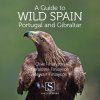Wildlife Guide
Out of Print
By: Clive Finlayson(Author), Geraldine Finlayson(Author), Stewart Finlayson(Author)
368 pages, colour photos
![A Guide to Wild Spain, Portugal and Gibraltar A Guide to Wild Spain, Portugal and Gibraltar]()
Click to have a closer look
About this book
Biography
Related titles
About this book
Language: English
A Guide to Wild Spain, Portugal and Gibraltar is a unique book that brings together the history of exploration of the Iberian Peninsula in the 19th Century with the current state of its wild places and wildlife. The authors re-trace the footsteps taken by British naturalists based in Gibraltar and Jerez over a hundred years ago. They explore the length and breadth of the peninsula, from the Strait of Gibraltar in the south to the Pyrenees in the north, and also take in the islands.
This exquisitely illustrated book is intended for all those with an interest in the natural history of Spain, Portugal and Gibraltar. It tells the reader where to go to find particular species and to witness natural phenomena like the migration of birds of prey. But it also tells how this has changed, often for the worse, but happily sometimes also for the better.
In essence, A Guide to Wild Spain, Portugal and Gibraltar is a 21st Century snapshot of one of Europe's ecologically richest lands.
Customer Reviews
Biography
Professor Clive Finlayson is a biologist and has been Director of the Gibraltar Museum since 1991. He is a member of the European Academy and his work has included research into the ecology of birds and, more recently, that of the Neanderthals. As well as producing many scientific papers and articles, he is also author of the popular Al-Andalus and co-authored the classic Birds of Iberia, both of which are published by Santana Books.
Dr Geraldine Finlayson is a biogeographer and Deputy Director of the Heritage Division of the Gibraltar Government. Her work has focused on landscape reconstruction, using information from Gibraltar’s caves to interpret how climate transformed the ecology of Iberia. She has worked on many field projects, including inside the Doñana National Park. Geraldine is also a director of the Gibraltar Museum’s Underwater Research Unit.
Stewart Finlayson, born in Gibraltar like his parents, is a keen naturalist and photographer and is reading for a PhD in Biology. Stewart is intimately familiar with the wildlife of Iberia, especially its birds. He has also participated in work in many areas of Iberia, including Doñana, the Pyrenees, Sierra de Gredos and Extremadura. Among his preferred study sites is the old lake of La Janda which was also a favourite of one of the 19th Century naturalists referred to in this book.
Wildlife Guide
Out of Print
By: Clive Finlayson(Author), Geraldine Finlayson(Author), Stewart Finlayson(Author)
368 pages, colour photos























